Ok, I’m aware that with this blog title, (ahem: Tom and Jerr) I’m giving a huge clue, but do you have any idea which cartoon character has won (by far) the most Oscars in film history? If you said Mickey Mouse, you’d be wrong. Only one cartoon, 1941’s Lend a Paw, a short in which he has Pluto as a co-star, was recognized in that way. So… maybe Bugs Bunny? Nope. He too only won once, for Friz Freleng’s Knighty Knight Bugs. As you may have guessed at this point, it wasn’t a single character, but the duo created by a duo, Bill Hanna and Joe Barbera’s Tom and Jerry that hold the record. That pair of furry frenemies have the most wins at the Oscars for in the animated short film category. What’s even more impressive is they won seven Oscars within only a ten year span!
Needless to say, Hanna and Barbera were a big fluffy feather in MGM’s cap, as all these Oscars came during their tenure at the studio.
A HISTORIC TWO-MAN TEAM

Let’s start with a little background on their creators, two men who ultimately changed the landscape of Saturday morning television, making history along the way. Bill Hanna and Joe Barbera were partners for over 60 years, longer than most marriages. Among the many things cartoon fans have to thank them for, is basically creating the concept of the “Saturday morning cartoons”.
Say what you like about their many equally beloved and reviled cheesy 70s cartoons. Once Hanna Barbera built their own studio, they were able to create dozens of characters and cartoons studied and sought out to this day. (Right here is where I mention there’s a great animation professor, art historian, and expert, Jerry Beck, who has written a book specifically about Tom and Jerry, but also about all the Hanna Barbera cartoons. To do a deeper dive into Tom and Jerry, or any number of other Hanna Barbera cartoons, you can buy his books HERE.)
As much as they may have built memorable stories and characters in cartoon form, in real life, they were in fact polar opposites. According to Hanna Barbera story artist Tony Benedict, Joe Barbera was a very flashy guy. He loved tailor-made suits, initialed ties, his Bel Air mansion, and keeping his skin bronzed with a great LA tan. In contrast, Bill Hanna was a dedicated outdoorsman with simple tastes, a hard-nosed businessman who held to a tight schedule. In their long career working together, they created many cartoons, including The Huckleberry Hound and Quick Draw McGraw shows in the 50s, The Flintstones, The Yogi Bear Show, The Jetsons, Top Cat, Jonny Quest, Space Ghost, and Scooby Doo, Where Are You? in the 60s, and Josie and the Pussycats, Super Friends, Hong Kong Phooey, Jabberjaw, and SOOOOO many others in the 70s. (Don’t come at me with the ones I haven’t mentioned…the fandom for specific HB cartoons is intense and obsessive!) After they founded their own studio in 1958, Hanna and Barbera won or were nominated for 8 Emmy Awards. MGM and Tom and Jerry was really the beginning of a successful lifelong partnership.
Barbera started his career as a tax accountant, but grew bored with that career, and added working as a commercial artist to feed his artistic soul. After having his illustrations published in Colliers, he quickly got involved in animation (especially after being fired from his tax job during the depression) first working as an in-betweener at Van Beuren Studios, then moving on to Terrytoons, before finding himself at MGM.
In contrast, Bill Hanna worked at the Harmon-Ising Studios, climbing the ladder there from janitor to head of ink and paint to building gags and becoming skilled at timing. When in 1933 Hugh Harmon and Rudolph Ising signed a deal with MGM to create animation, Hanna continued to work with them, directing his first short with 1936’s To Spring. It’s a bit dated compared to shorts released even a decade later, but a lovely example of animation from that era.
In 1937, Harmon and Ising moved on from MGM, but Hanna stayed on, working with producer Fred Quimby, who was the head of the MGM animation studio.
Cartoons fans will likely recognize his name due to its prominence in the credits of the over 250 shorts he produced. In fact, although he was the head of the MGM animation department, he had no prior experience in the medium, and acted almost exclusively as a liaison between the animation department and studio executives. A humorless guy, after their first appearance in 1940’s Puss Gets the Boot, he believed the characters that would become Tom and Jerry had no future, and Hanna and Barbera had to fight to be allowed to work on more shorts featuring the pair. He was, however, all too happy to accept all the credit and keep any and all Oscar wins Tom and Jerry and any other MGM cartoons received. All the animators loathed him. (See Joe Barbera’s distain for him in an interview HERE.)
THE BIRTH OF JASPER AND JINX aka TOM AND JERRY
Anyway, there Hanna was, at MGM, and now both he and Barbera were working at the same studio. In a story meeting together, Barbera suggested they create their own cartoons. They settled on a cat and mouse. Not yet called Tom and Jerry, they debuted as Jasper and Jinx in the above-mentoned Puss Gets the Boot in 1940. You’ll find their design for the characters very much finished, but it wasn’t until their second cartoon, The Midnight Snack, that they were dubbed Tom and Jerry.
There’s some argument about how they got their final monikers, but the official story is they had a studio contest to rename the characters, and an animator named John Carr won the first place prize of $50 for suggesting Tom and Jerry. Another story lists a long series of influences, starting with a Damon Runyon story from 1932 and tracing it all the way back to the early 1800s and a series written by journalist Pierce Egan in the 19th century tome Life in London, where it referenced young men of disrepute given to gambling and high jinks.
As to script, though supporting characters in Tom and Jerry had lines, the two main characters rarely spoke as part of their cartoons. There were a few notable exceptions, including Puss Gets the Boot. It’s far more often the case that Tom sings, as most memorably exampled by “Is You Is or Is You Ain’t My Baby?” in 1946’s Solid Serenade. (You can watch him perform Louis Jourdan’s hit at the bottom of this blog).
As you can see by this video, “Puss Gets the Boot” led to the two’s first Oscar nomination, but it suffers from some of the problematic portrayals of the time…
The first Oscar nomination that officially counts is 1941’s The Night Before Christmas, only the second short in which the duo were known as Tom and Jerry. It’s one of my favorite Christmas cartoons, and for good reason. It hits all the warm fuzzy spots of the season:
That’s the year Mickey’s one and only Oscar win happened for Lend a Paw, which is a bit odd, since Pluto is really the star of that short. It’s the one where Mickey finds a kitten and Pluto has a moral conundrum about what to do with it. A fight between the angel and devil on his shoulders ensues. That year saw the beginning of a lot of military and war-related cartoon shorts, including How War Came, in which a famous commentator tries to explain the beginning of the war. You can see that short and read more about it on Jerry Beck’s blog about it, HERE.
A 10-YEAR WINNING STREAK
1943 started a 10-year streak of wins and nominations for Hanna and Barbera’s Tom and Jerry. The first was for the 11th Tom and Jerry cartoon, The Yankee Doodle Mouse, which represented a technicolor wartime message of strength, resilience, and determination by the MGM animators. Note the fact that although Hanna and Barbera are credited in one of the first opening titles, Fred Quimby gets the final and most dramatic credit. That’s in contrast to many Looney Tunes Warner Brothers shorts, where the director nearly always got the biggest and final credit in the titles. Boooo to Fred!
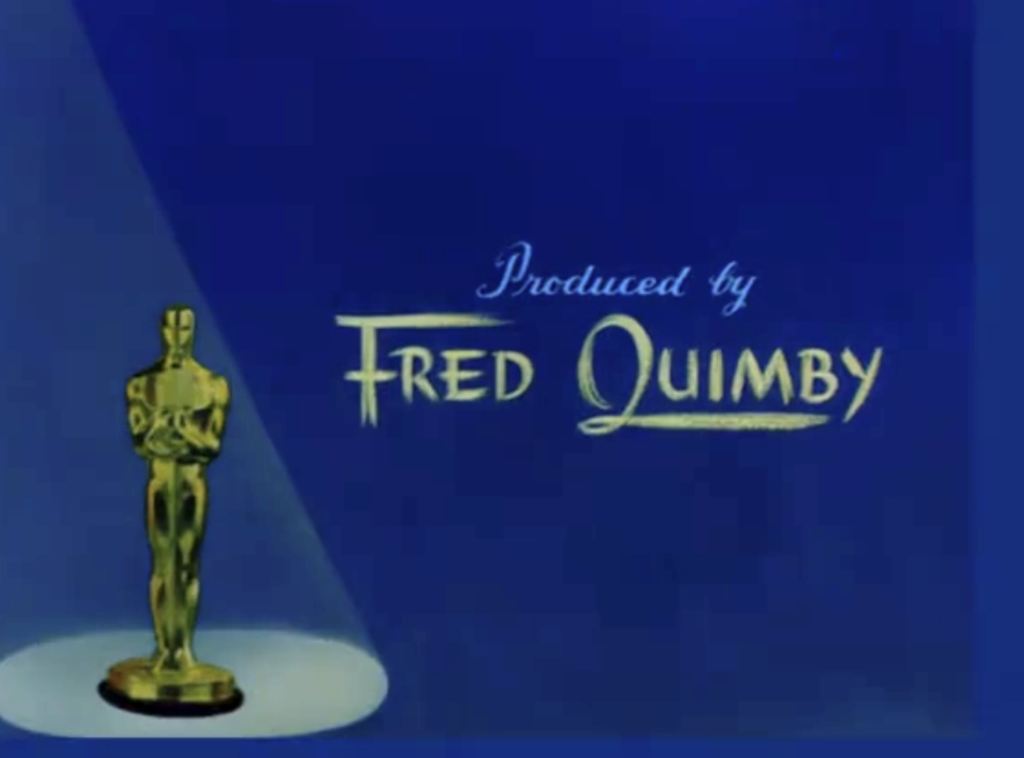

1944’s Mouse Trouble is Tom and Jerry’s 17th one reel short, and the second consecutive win at the Oscars for Hanna and Barbera. They’re really on a roll here! Bill Hanna supplies Tom’s voice, as he deadpans to the audience, “Don’t you believe it.”. Vaudeville actress Sara Berner voices the mouse toy. It’s one of the shorts from the series in which Tom dies, although he never dies for long, having, as cats do, 9 lives. You can see both the girl mouse toy and Tom’s demise in this video:
The next winner was 1945’s Quiet Please, and features Spike the Bulldog in his 4th appearance. Voice actor Billy Bletcher contributes his voice, in a cartoon in which Tom actually speaks through the voice of Bill Hanna when he says “One custard pie? Let me have it!”.
In 1947, pianist Tom performs Hungarian Rhapsody No 2 by Franz Liszt. It too won an Oscar, but is, in fact, the only Tom and Jerry cartoon to make the Top 50 Cartoons of All Time list, coming in at 42. Oddly, the same year another famous cartoon came out that was extremely similar, Rhapsody Rabbit, even featuring the same classical piece. It may be true that plagiarism played a role, because Rhapsody Rabbit has as an early MPAA copyright, and Technicolor was accused of sending a copy of the Bugs cartoon to MGM. Since Cat Concerto was played first for Oscar contention, when people saw Friz Freleng’s Bugs cartoon, they assumed he was the thief. Friz, known as a bit of a hothead, was quoted as saying, “No, no, no! I never saw your g-damned lousy cartoon!”
The Little Orphan, released in 1949, features Nibbles (also known as Tuffy!) in his second appearance., with Tom and Jerry in a Thanksgiving gambit. Rife with problematic references to indigenous and Black folk, it’s a product of its time. My own experience is I found production cels made for an updated sequence created by Chuck Jones in which the scene was altered, presumably because the moment was so racist…it showed Tom lit on fire and, after burning, is left looking blackened in a way reminiscent of a Black stereotype called a “picaninny”. (click on the word to learn more about that caricature’s history from the Jim Crow Museum page). At the time, it took a LOT of research to figure that out.
With this short, Hanna and Barbera’s series tied with Disney’s Silly Symphonies for the most Oscars. Nibbles/Tuffy appears in two Oscar-winning Tom and Jerry shorts.
1952’s The Two Mouseketeers is a personal favorite, not least because I’m French. Granted, it’s yet another example of Dumas being leveraged for laughs (there are many comedic entries in shorts and feature films that use his story as inspiration) but who doesn’t love Nibbles yelling “En guarde!”? on the other hand, it is a short not shown as often as many other Tom and Jerry cartoons because Tom is guillotined at the end. By the way, my family is related to the executioner of Marie Antoinette, which is far less delightful as sounds, given the number of innocent men, women, and children (and cats, apparently!) killed during the revolution. Still, it’s a truly great example of timing and character.
The last Oscar winner is 1953’s Johann Mouse. It’s particularly interesting for the illustrative aspects included in the short, for the narration, supplied by character actor Hans Conried, and piano playing from Polish pianist Jakob Gimpel included as part of the story. Gimpel had played for many MGM titles, including Gaslight and The Mephisto Waltz, but is also the pianist standing in for Bugs in Rhapsody Rabbit.
**Bear in mind that lthough I’ve tried to supply links to these Oscar-winning shorts (and they may become broken links), they are currently all available as complete cartoons streaming on Max.
Here is Joe Barbera talking about creating Tom and Jerry with Bill Hanna:
In its original run through MGM, Hanna and Barbera created 114 theatrical shorts. Are the 7 that won Oscars the best of the best?
You’d have to watch all 141 to decide, but certainly they represent a mastery of timing, squash and stretch, and other important aspects that animators in the 50s, 60s, and beyond used as inspiration in their own work.
One such artist, who spent over two decades at Hanna Barbera Studios, is Bob Singer. He studied the early Tom and Jerry cartoons for his own work. It’s for that reason he was inspired to created images from Oscar-winning cartoons of that era for a series of limited editions, all available for purchase on our website!
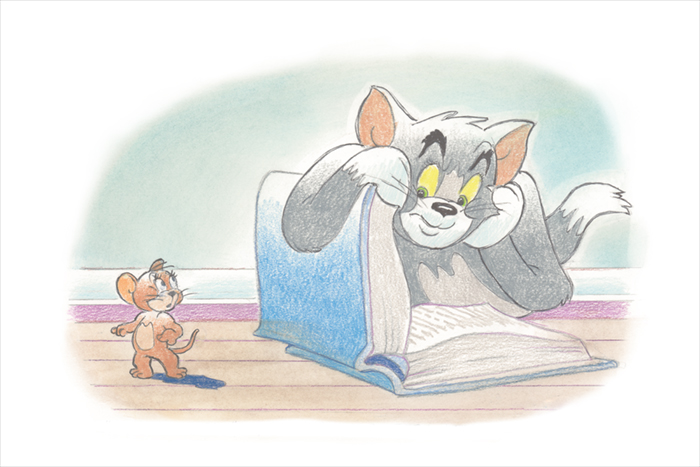
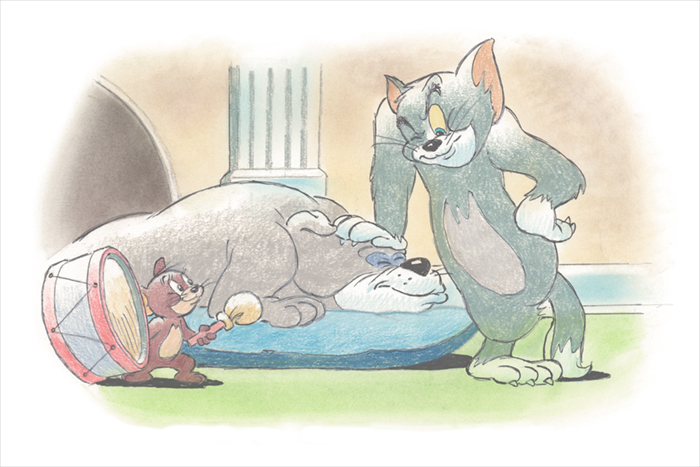


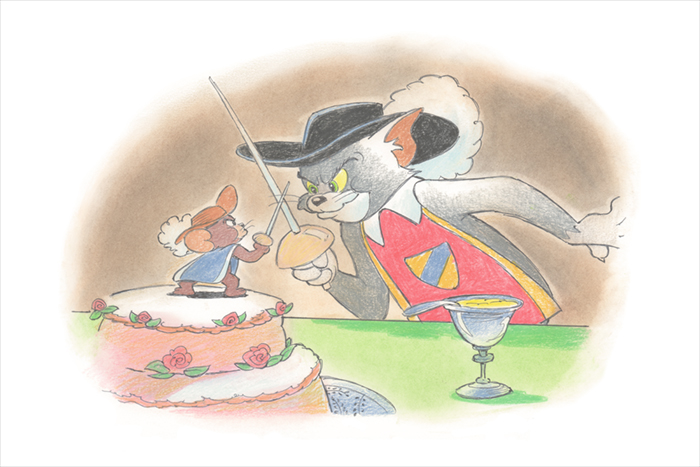
Of course, Tom and Jerry went through several other permutations over the years. For example, between 1963 and 1967, Chuck Jones produced 34 cartoons starring the cat and mouse team, often working with background and concept artist Maurice Noble. The characters looked a little different, and you can definitely see his style in story, animation, and character design. In those shorts, occasionally the voices of Mel Blanc and June Foray can be heard. There are also several tv shows dedicated to the pair done in the 60s and 70s. There was, (oh the horror!) it must be mentioned, the Filmation Era in the 80s, which is truly an abomination.
Most recently, starting in the early 2000s, Warner Brothers, which owns the MGM library, resurrected the characters. There are a number of newer cartoons featuring Tom and Jerry in which they exist in more modern environments.
Apart from the appearance of Tom and/or Jerry in feature films in the 40s and 50s like Dangerous When Wet (with Esther Williams) and Anchors Aweigh (with Gene Kelly), Tom and Jerry starred several feature films in the 1990s and 2000s. A new series premiered in 2021 on MAX, called Tom and Jerry in New York inspired by one of those features.
Whether better (Chuck Jones) or worse (Filmation), every single short created after Hanna and Barbera’s heyday at MGM show what truly beautiful great examples of animation those historic Oscar-winning shorts from the MGM era are.
—
Speaking of beautiful art, if you love all these Tom and Jerry cartoons, you can always buy a set of all Bob Singer’s images! Click below for more info:
===
Here, as promised, is Tom singing “Is You Is or Is You Ain’t My Baby?”, with lyrics so you can sing along!:


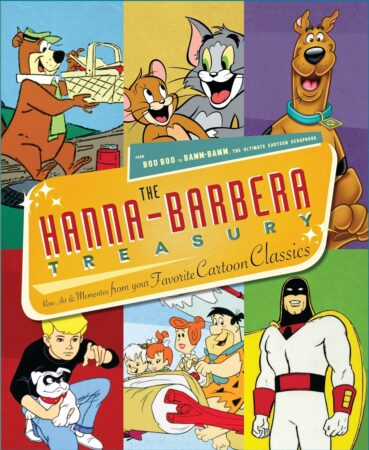
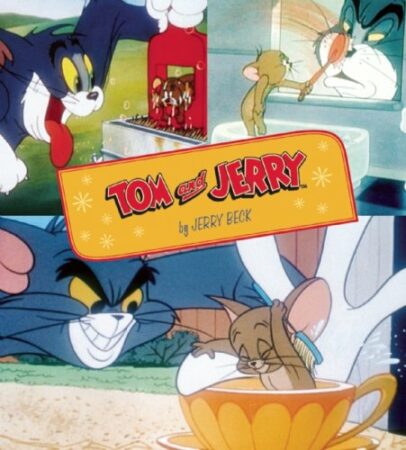

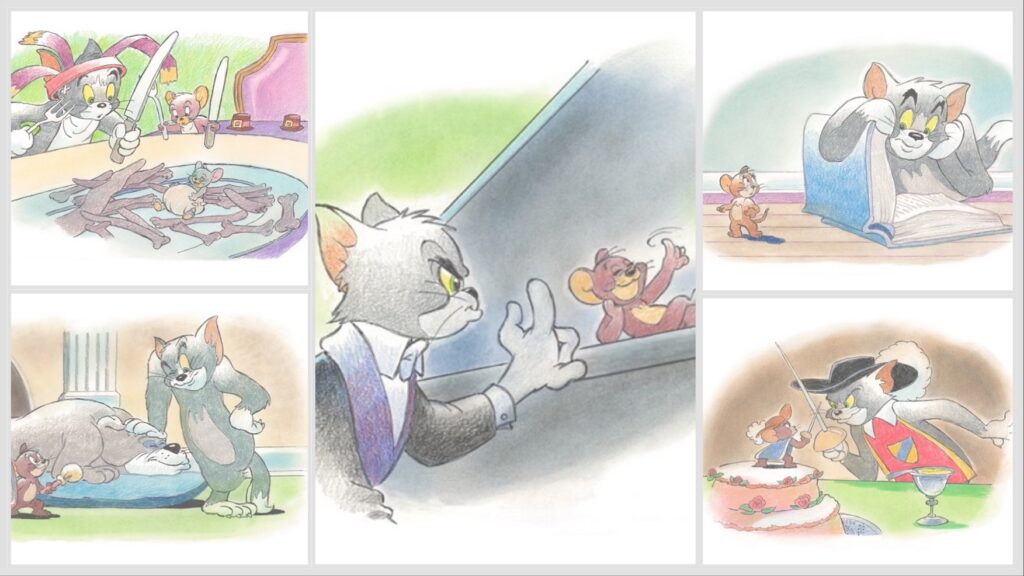
I can’t remember a time when I wasn’t watching Tom and Jerry! Thank you for this wonderful piece.